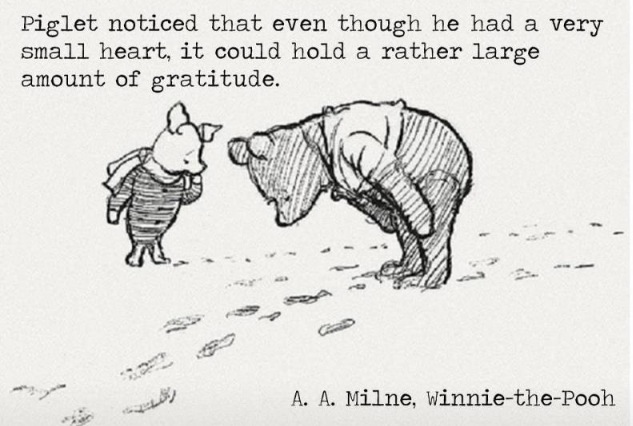Thinking about this time of year and my family and with the New Year’s just ahead got me reflecting on the idea of gratitude. Growing up, one of my family’s favorite holidays was Thanksgiving… not so much for the significance of the history of the holiday, but certainly as a coveted time to be together as a family, and to celebrate all of the things in our lives we were appreciative of. There were many ways we demonstrated our thanks over the years in my family. It was an important ritual for me.
When I think of some of the values we try to help instill in our MSB students, one that comes to mind is gratitude.
It’s so easy to float through life, especially as children and take things for granted. Here are some ideas to initiate activities and conversations with your children around the idea of being thankful, grateful, and what it means to be blessed. Enjoy.
1. The Gratitude Jar

Have your child help decorate a glass vase or jar with sparkles and hearts, glitter, etc. Next to the jar, place strips of paper with a pencil. Have each member of the family make a daily, nightly, weekly practice of thinking of something that happened for which they are grateful. Something that made you laugh, or smile, or feel good. If your child is not old enough to do the writing, ask them to tell you and you write it and read it back to them. Have them drop it in the jar. Then, on a nightly, weekly basis, collect the strips and have a family meeting to reflect on all of the things the family was grateful for today/this week. Recall ”whose was whose.”
2. Gratitude Journal

This can also be a way to help your child begin to embrace journaling, which is such a healthy outlet for expressing all sorts of feelings. Children who are artistic and highly creative also enjoy embellishing a journal with art and coloring and other decorations, which in itself, is meditative and calming – and another thing to be grateful for! And later, if your child is having an “off” moment, a tough day, or just needs some reassurance, you can have them read a page from their gratitude journal as a way to reconnect with their own joy. 😊
3. Read Stories with a Message of Gratitude
Here are some titles to get the conversation going. I can remember when I was a younger child, my mom helping me through a tough time by asking me to think of things I was grateful for. What a great way to initiate this using a book:

Thankful, by Eileen Spinelli
A brother and sister explore different ways of life and the many things different people have to be thankful for.

Thank You Body, Thank You Heart, by Jennifer Cohen Harper
This book offers a bedtime ritual of gratitude, guiding kids through the practice of giving thanks for the bodies and minds that carry them through life.

Thanks a Million, by Nikki Grimes
This collection of kid-friendly poems teaches children about the many reasons to be grateful and the power of saying “thank you.”
And here is a whole list of books on the theme of gratitude:
https://www.huffpost.com/entry/childrens-books-gratitude_l_5dd5b609e4b0e29d727e690a
4. Acts of Kindness/Service

Teaching children to be thankful can also involve teaching them to give back. Help your child find a way to engage in small acts of kindness, like making cards for elderly neighbours, helping set the table for dinner, or baking someone a loaf of bread. These actions help them understand the joy of giving.
5. Volunteer Together
Consider involving your child in an age-appropriate volunteer opportunity. This hands-on experience will teach them the value of giving back and the importance of gratitude in action.
These activities not only bring the spirit of gratitude to life but also help children understand the true meaning of giving thanks for what we have and showing appreciation to the people around us. By making gratitude a part of their daily lives, children can carry the lessons of thankfulness with them throughout the year.
THE BENEFITS of GRATITUDE
However you may implement thankfulness into your family life, the scientific community reports that there are actually physiological benefits that come from practicing an attitude of gratitude:
a. Gratitude can open the door to new relationships. A 2014 study reported that thanking a new acquaintance makes them more likely to seek an ongoing relationship. Acknowledging other people’s contributions can lead to new opportunities and saying “thank you” is not just good manners; it may help us to win new friends.
b. Gratitude improves physical health. According to a study in 2012… people who expressed gratitude experience fewer aches and pains. They also are also more likely to take care of their health. They exercise more often and are more likely to attend regular check-ups, which is likely to contribute to further longevity.
c. Gratitude improves psychological health. Being thankful was found to reduce a multitude of toxic emotions, from envy and resentment to frustration and regret. Studies show that gratitude effectively increases happiness and reduces depression.
d. Grateful people sleep better. Writing in a gratitude journal improves sleep, according to a 2011 study published in Applied Psychology: Health and Well-Being. Spend 10-15 minutes jotting down a few grateful sentiments before bed, and you may sleep better and longer.
e. Gratitude improves self-esteem. A 2014 study published in the Journal of Applied Sport Psychology found that gratitude increased athletes’ self-esteem, an essential component of optimal performance.
We all have so much to be thankful for. As teachers and parents, let’s make sure we model appreciation for all of our blessings and teach our children how to be full of thanks and mindful of all of the good things that come our way, each and every day.


























